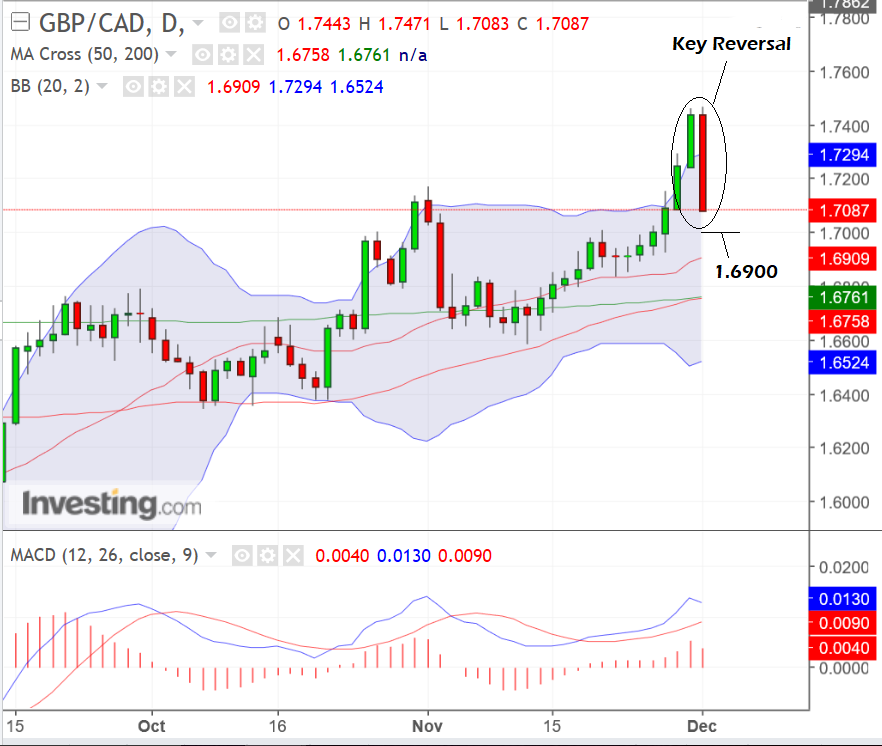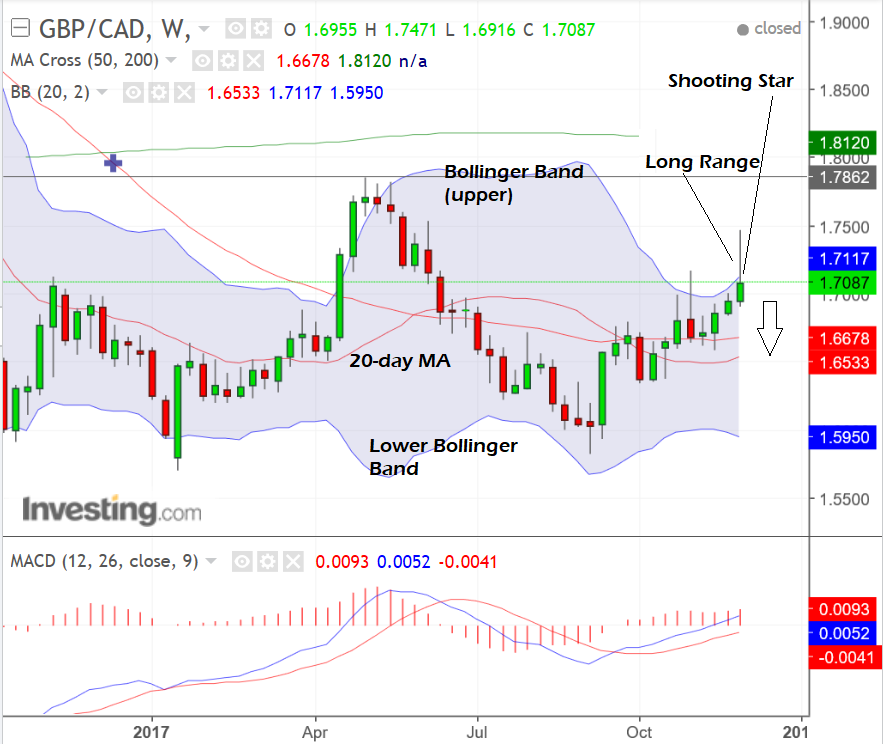Pound-to-Canadian Dollar Rate: Technical Forecast, Data and Events to Watch in the Coming Week

Chart studies suggest the Pound could be about to turn lower against the Canadian Dollar, but a Bank of Canada event and Brexit negotiations could provide heightened volatility this week.
The Pound has advanced 3.42% against the Canadian Dollar over the course of 2017 while the past month-to-date has seen a 2.27% rise taking the conversion to 1.7115.
This hints that the lion's share of the gains are quite recent and therefore perhaps near-term momentum is to be in the British Pound's favour.
However, our studies take a different view having noted both the daily and weekly charts of the Pound-to-Canadian Dollar exchange rate are showing relatively reliable negative indicators, strongly suggesting more downside is on the horizon for the exchange rate.
Last week saw GBP/CAD rise steeply, peak at 1.7471 on Friday and then roll-over and fall to 1.7087 all on the same day.
The spike and then reversal lower can clearly be seen on the weekly chart, in fact, price action last week has formed into what analysts call a shooting star candlestick, which is a bearish pattern.
The shooting star also has a very long range which is even more bearish - meaning indicative of more downside to come.
In addition, if we overlay a Bollinger Band, which is a price jacket which wraps around price, at two standard deviations from the 20-day moving average (MA) of the price, the shooting star with the longer-than-average range pokes well above the upper Bollinger Band, and when this occurs it is a very bearish sign.
There is now every indication that the exchange rate could move lower.
If we look more closely at the daily chart we also note an important indication the exchange rate could go lower, after price action on Friday formed a bearish key reversal pattern.
This occurs when the exchange rate rises, peaks at a new high and then moves down steeply to close well below the low of the previous day.

When this happens it is a strong bearish sign that the trend may be changing and further suggests lower prices on the horizon.
We expect a continuation down to a target at 1.6900, subject to the exchange rate breaking down below the 1.7000 level.
Get up to 5% more foreign exchange by using a specialist provider by getting closer to the real market rate and avoid the gaping spreads charged by your bank for international payments. Learn more here.
Data and Events for the Canadian Dollar
The main event for the Canadian Dollar in the coming week is the meeting of the Bank of Canada (BOC) on Wednesday, December 6, at 15.00 GMT.
A string of strong data releases had heightened expectations that the BOC may raise interest rates, or if not then signal that they probably will quite soon.
In the previous week, extremely strong Employment data on Friday showed the strongest growth in jobs for 4 years with an increase of 79k jobs in November, and this helped propel the Canadian Dollar so much higher, that it made back all the loses incurred at the start of the week.
Stronger-than-expected GDP data in September also helped the Canadian Dollar higher.
"The Bank of Canada has less to worry about in December than in October because everything from retail sales, to the labor market, housing market, manufacturing activity, trade and oil prices improved since the last meeting. The only area that deteriorated was inflation," says BK Asset Management Managing Director Kathy Lien.
Toronto-based investment bank TD Securities, meanwhile expect BOC Governor Poloz to sound much more upbeat after the meeting and see the chances increasing of a January rate rise from the current 50% market expectation.
"The remarkable progress in the labour market will give Poloz a reason to sound upbeat in the policy statement. Wage growth has accelerated sharply and GDP growth has printed in line with MPR projections. Markets are still priced below 50% for a January rate hike which should rise on a subtle pivot from Poloz," said TD.
On the hard data front, Canadian PMI data called the 'Ivey PMI, which is based on surveys with key managers in leading sectors of the economy and is considered a strong leading indicator for the economy is out on Thursday at 15.00.
Data and Events for the Pound
The main fundamental drivers dictating price action at the moment are political in nature and focused on the twin concerns of how Brexit talks are going, and how stable the government is, and this is likely to continue in the week ahead.
The Pound rose last week on news the deadlock in Brexit negotiations had been broken, and the two sides were close to agreeing on a divorce bill, the Irish border, and citizen rights. Should this be confirmed at the mid-month European Council meeting of E.U. leaders talks will be allowed to move onto the more important subject of trade.
Yet, ultimately nothing has been confirmed and the Pound has risen on hearsay alone so there are risks of disappointment.
There is a possibility more concrete confirmation may be forthcoming in the week ahead when Theresa May visits Brussels to talk 'turkey'.
"Next week, May heads to Brussels to meet with Jean-Claude Juncker and this is her first opportunity to provide the U.K.'s divorce bill offer and to talk about their plans for the Irish border. Then on December 6th, EU ambassadors resume preparations for the summit," says Lien.
The other main political driver impacting on the Pound is the stability of the government.
From a hard-data perspective, the week opens with Construction PMI at 9.30 GMT on Monday, December 3 which will give us insights into how the sector fared in November.
The consensus amongst analysts is that it will rise to 51.0 in November, from 50.8 in October.
Services PMI is on Tuesday at the same time and is forecast to fall to 55.0 from 55.6 previously; this is the most important reading of the week as the services sector accounts for more than 80% of U.K. economic activity.
Analysts at TD Securities think the market is underestimating the sector and a pro-Sterling result beat on expectations could be delivered:
"We look for upside risks to the November Services PMI. Spillovers from optimism in the manufacturing sector (where business-to-business activity has remained strong) as well as from the rest of Europe (where the PMIs and growth are accelerating into year-end) should help support optimism in the sector."
The week ends with the Trade Balance and Industrial and Manufacturing Data out at 9.30 on Friday, December 8.
The trade deficit is expected to widen slightly to -11.5bn in October from -11.25bn and confirm the country's hefty reliance on imports remains intact; something that concerns analysts who believe the Pound could one day have to adjust materially lower in order to balance the situation.
Both Manufacturing and Industrial production are forecast to rise by 0.1% in October; disappointment here could see Sterling end the week in soft fashion.
Get up to 5% more foreign exchange by using a specialist provider by getting closer to the real market rate and avoid the gaping spreads charged by your bank for international payments. Learn more here.





